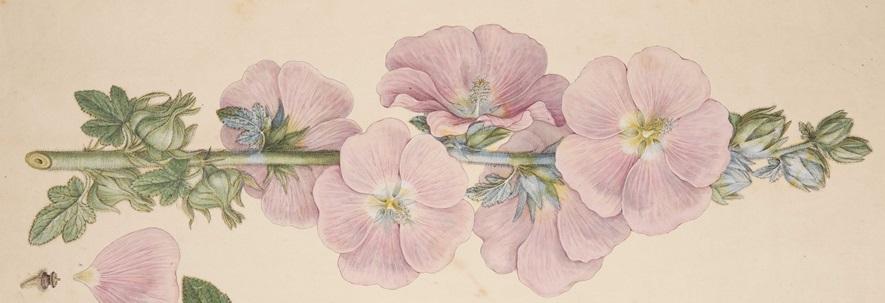
As befits one of the largest and oldest herbaria in the UK, Cambridge University Herbarium has a rich and storied history, featuring cameos from some of the most influential figures in natural history.
18th Century – Beginnings
The history of the herbarium starts over 260 years ago, with a generous gift. In the 1760s, John Martyn (1699-1768) gave his Hortus Siccus (literally ”Dry Garden”) and botanical library to the University of Cambridge. The gift accompanied his retirement from his position as the second professor of botany and of his original collection (the size of which is unknown) at least 3,000 specimens survive today.
Martyn was succeeded as professor of botany by his son, Thomas (1735-1825). Thomas Martyn meticulously curated his father’s specimens, labelling them with their binomial (genus and species) names, with reference to Carl Linnaeus’s Species Plantarum. In the latter half of Thomas Martyn’s tenure, he could not convince the University to better accommodate the specimens and, attacked by pests and damp, their condition greatly deteriorated. Thus, the challenge of saving the herbarium was passed to his successor.
19th Century - Henslow Comes to the Rescue
In 1825, John Stevens Henslow (1796 - 1861) took up the chair of botany and prioritised rescuing and later expanding the herbarium. He painstakingly remounted over 3,000 of John Martyn’s original specimens, added over 3,500 of his own, and acquired many further specimens through his extensive connections within the British scientific community. Henslow used the herbarium collections extensively in teaching and some of the materials he developed - hand-drawn illustrations and diagrams - were used in university teaching until the mid 20th century. Henslow’s teaching influenced a generation of natural historians, including the man who would go on to revolutionise our understanding of the natural world.
Charles Darwin (1809-1882) was a keen botanist, in large part thanks to Henslow’s influence and teaching. During his famous five-year voyage aboard HMS Beagle (1831-1835), he collected around 1,400 botanical specimens. He sent these specimens back to Henslow for mounting and labelling and the vast majority are now held in Cambridge University Herbarium. The Herbarium also holds material collected by Darwin in the UK, including the earliest specimens attributable to him.
Henslow was succeeded by another former student, Charles Cardale Babington (1808-1895), who became fifth professor of botany. Babington contributed c. 55,000 herbarium sheets from his personal collection and acquired many other collections of similar size, including the herbarium of John Lindley. Babington also oversaw the hiring of the herbarium’s first Curator in 1880, and the reorganisation of the herbarium in accordance with George Bentham and Joseph Dalton Hooker’s Genera Plantarum.
20th Century – A Century of Change
The next big change for the herbarium came in 1904, with the opening of new Botany School building on the Downing Site in Central Cambridge. This building, which is still home to the Department of Plant Sciences, contained purpose-built space to house the herbarium. Settled in its new location, the Herbarium acquired more major collections during the first half of the 20th century, including material from India, North America and the UK.
The second half of the 20th century saw particular expansion and use of the Herbarium’s British and Irish Flora. The collections were an important resource for two major reference works: Flora Europaea (published in six volumes between 1964 and 1993) and Flora of Great Britain and Ireland (published in 5 volumes between 1996 and 2018). The latter was written by two of the Herbarium’s Assistant Curators, Peter Derek Sell and Gina Murell, who also contributed over 50,000 new British and Irish specimens to the collection.
At the same time, however, traditional taxonomy was falling out of fashion and UK universities were shifting the focus of their research and teaching to other areas of plant science such as physiology, ecology and molecular biology. The School of Botany was renamed the Department of Plant Sciences to reflect this shift. By the beginning of the 21st century, the herbaium facilities - state-of-the-art a century earlier - were no longer suitable and, following the retirement of the Assistant Curator in 2012, the herbarium had no full-time staff (only one part-time technician) for over five years.
21st Century - A Bright Future
In 2011 the herbarium moved to new facilities in the £82 million Sainsbury Laboratory building, adjacent to Cambridge University Botanic Garden (CUBG). The building is funded by the Gatsby Charitable foundation and contains modern compactor storage, workspace for mounting and digitising specimens and -30°C freezers for quarantining material. Six years later Dr Lauren Gardiner was appointed as curator and has set about revitalising the herbarium and securing its long-term future. One of her major achievements has been securing Designated Status for the herbarium. Awarded in 2022 by Arts Council England, this recognises the outstanding national importance of the collections.
The herbarium now holds over 1.1 million specimens and is still growing. It receives material from international expeditions conducted by CUBG and was recently bequeathed the personal herbarium of the academic and author Oliver Rackham. Older specimens are also being rediscovered. In recent years specimens collected by Darwin have been newly discovered, some still wrapped in the newspaper in which they were collected.
It follows that a central priority for the coming years is increasing accessibility of this scientific treasure trove by databasing and digitising the collections, hosting researchers, forging collaborations and embedding the collections in university teaching. Our team of researchers and volunteers are working hard to make this happen and with over 260 years of history now behind us, the herbarium is looking forward to a bright future!
